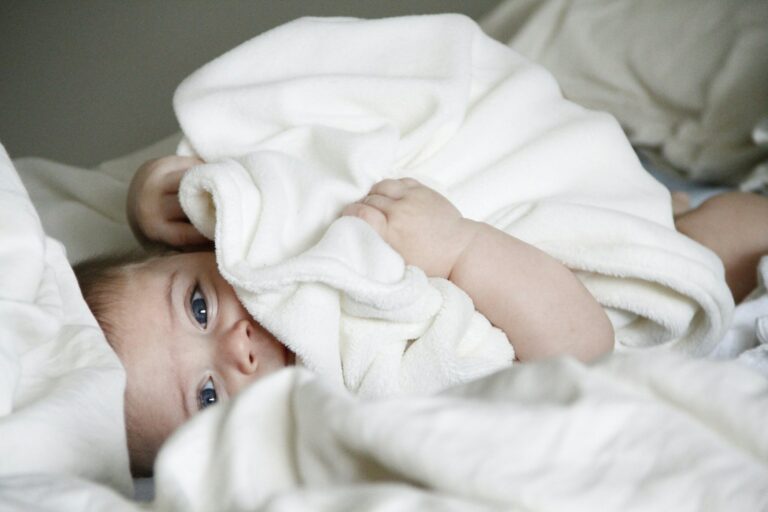A tiny sigh in the dark, eyelids fluttering, the hush of a nursery – every parent, at some point, encounters the mysterious labyrinth of baby sleep under 1 year. There are questions that swirl endlessly: Why won’t my baby sleep longer? Is it normal for newborns to wake again and again? When does this end – or at least, become bearable? Rest easy, because understanding these early months unlocks a cascade of solutions to foster rest for both baby and family. What does restful slumber look like in real life? How can you gently guide your baby towards sleep that is as nourishing as their daytime feeds? The landscape of infant sleep is rarely smooth, yet with practical support and evidence-based insight, you’ll find the compass parents everywhere are searching for.
Understanding Baby Sleep Under 1 Year: What Really Happens?
Picture those early days – moments blurring together as night and day seem interchangeable. Newborns, with their immense sleep needs, drift in and out of rest for 14 to 17 hours per day, sometimes more. This high demand is not random; the developing brain weaves memory, strengthens immune defenses, and lays the foundation for emotional growth while a baby slumbers. Yet, paradoxically, these stretches of sleep are fragmented – lasting just one to three hours at a time (how many times have you counted your baby waking at night?). As the months pass, an astonishing recalibration begins. The disjointed patterns of a newborn evolve, increasingly favoring longer nighttime sleep and consolidated naps.
By the first birthday, most infants are clocking a steady 12 to 16 hours in 24 hours, with two longer daytime naps becoming the norm. The circadian rhythm – an internal clock shaped by exposure to light and daily routines – takes root, gradually teaching your child the difference between night and day. Have you noticed signs like yawning, rubbing eyes, or a sudden crankiness? These are powerful biological cues indicating your baby’s readiness to transition into sleep. Flexibility, above all, is your ally: each baby’s sleep journey, especially under a year, is beautifully individual, frequently reshaped by surges in development or changes in feeding.
The Irregular World of Newborn Sleep (0–3 Months)
Stepping into the realm of the newborn, sleep is a patchwork, stitched together with frequent awakenings driven mainly by a need to feed. Their tiny stomachs – barely the size of a walnut – demand regular refills, leading to no discernible day or night preference. Around 50–60 minute cycles are the rule, alternating between periods of REM (rapid eye movement) sleep and deep, restorative non-REM sleep. Each transition is punctuated by brief arousals; it’s part of healthy neural maturation.
Want to support your baby in this wildebeest-lively rhythm? During the day, let light filter into the room, reinforce gentle household activity, and contrast this with calm, dark spaces at night. Safe sleep – always on their back, in a firm crib, no loose bedding, and a room temperature of roughly 18 to 20°C – remains paramount. Swaddling (only before rolling commences), white noise that mimics the gentle whoosh of the womb, and minimal stimulation during late-night feeds all offer reassurance and gradual acclimatization to circadian cues. Sometimes, the simplest interventions, such as a soft voice or gentle touch, solidify this growing sense of security.
Evolving Sleep Patterns: 1 to 6 Months
By the close of the first month, flickers of a day-night pattern emerge, although unpredictability persists. Some lucky parents encounter rare five-to-six hour night stretches; for most, broken nights remain the reality. At this stage, the sleep architecture – the way sleep is organized between light and deep phases – starts its metamorphosis. The restless and easily disrupted cycles of the earliest weeks give way, slowly, to deeper nighttime sleep and a more predictable rhythm.
Here’s something reassuring: no scientific formula dictates the “right” number of hours. Averages exist, for sure – 12 to 16 hours over the 24-hour cycle is referenced often – but significant variation is the rule. For many babies, night wakings persist, fuelled by hunger (with breastfed infants often feeding more frequently due to faster digestion compared to their formula-fed peers). Unless health professionals recommend otherwise, you don’t generally need to wake a thriving baby for night feeds.
Maturation and Shifting Sleep Needs (4–12 Months)
By 4 to 6 months, sleep for most babies transforms from raw anarchy to something a little more refined: two to three naps become the typical daytime arrangement, with nighttime stretches lengthening. Wake windows (the time a child can handle being awake before needing sleep) gently expand from the tight 1–2 hour slots of newborn life to an impressive 3–4 hours by twelve months. Many parents suddenly find themselves navigating new challenges: motor milestones such as rolling, crawling, or standing spark thrilling but disruptive leaps, shaking up even the most reliable of routines.
Around the 6 to 9 month zone, 11 to 14 hours in 24 hours is common. Multiple night wakings remain perfectly in the spectrum of normal – at this age, biology still trumps all scheduling ambitions. By 10 to 12 months, many babies settle into two predictable naps, but hurdles like separation anxiety can appear, painting evenings with new waves of resistance. Adjusting bedtime earlier and maintaining routines, particularly during developmental shifts, can help prevent a build-up of overtiredness (a paradox – the more tired a baby grows, the harder sleep becomes).
Parental Fatigue and Nighttime Struggles: Why Rest Matters for Everyone
As milestones mount and babies grow more aware, bedtime can morph into a battleground. The human brain is wonderfully adaptive, but with increased self-awareness comes a new suite of sleep reluctance – some children fear falling asleep (yes, really), while others struggle with the pangs of separation from their primary caregivers. During these times, it’s easy for parents to feel overwhelmed and depleted.
It’s not merely a baby’s sleep under 1 year that changes – parental fatigue, too, peaks in these months. Taking naps during the day (even those awkward, fleeting minutes as your child sleeps), sharing nighttime duties, or calling on trusted friends and family isn’t indulgence, but necessity. Remember, your own health and availability to your baby is intimately tied to your rest.
What Shapes Baby Sleep Under 1 Year? Unpacking the Science
A tapestry of factors shapes sleep in these formative twelve months. Feeding stands front and centre – the structure and content of feeds (breastmilk or formula) influence how long an infant stays full, impacting sleep duration between wake-ups. Growth spurts, teething, newfound skills, brief illnesses, or digestive hiccups can all ripple through established routines.
How can parents gently navigate this whirlwind? Tips for optimising baby sleep under 1 year include:
- Keeping nighttime feeds low-key, with soft speech and dim lights.
- Checking nappies, ensuring climate comfort (room temperature is key), and selecting season-appropriate clothing.
- Always placing baby on their back and using a firm, flat sleep surface.
- Steering clear of soft bedding, pillows, positioners, or sleep aids not approved by healthcare professionals.
Science of Safe and Healthy Baby Sleep
When it comes to infant sleep safety, details matter. Always lay your child on their back for every nap and night session. Choose a crib or bassinet with a smooth, fitted sheet – and absolutely no loose blankets, pillows, bumpers, or plush toys. Room-sharing (baby in the same room, but a separate sleeping surface) is recommended for at least the first 6–12 months, a practice associated with a lower incidence of Sudden Infant Death Syndrome (SIDS).
Swaddling can soothe non-rolling babies, but must stop immediately if rolling begins. Use only safe sleepwear, never hats or overheating layers. Sleep positioners, wedges, or soft inserts can increase risk, as can exposure to smoke or strong odours. Pacifiers, interestingly, demonstrate a protective effect against SIDS when used consistently, but only once breastfeeding is well established.
Building Predictable Sleep Routines
No magic wand conjures perfect routines, but ritual transforms chaos into predictability. Many families find a bath, short story, gentle lullaby, and cuddling signal sleep time’s approach far better than any clock. Developing consistent habits (yes, even on weekends) establishes a gentle “pre-sleep” association that supports both falling asleep and returning to sleep when stirring occurs at night.
Place your baby in their sleep space drowsy but awake. This small shift helps them learn to self-settle and reduces the likelihood of dependence on rocking or feeding to sleep. Two to three daytime naps remain essential, with flexible timing based on your child’s cues.
Sleep Rituals and Sense of Security
Ritual is powerful – babies as young as four months can start to link certain actions, soundscapes, or sequences with the approach of rest. The sense of reassurance provided by a consistent, gentle bedtime routine can smooth the transition into night, even as cognitive and emotional leaps occasionally disrupt the flow.
Optimal sleep associations – falling asleep in their own sleep environment, not in arms or at the breast – build resilience and confidence. Calm repetition is your ally in establishing positive habits.
Navigating Sleep Challenges: Medical Insights and Everyday Solutions
Night wakings abound – for most infants under a year, sleeping through the night remains a long-term aspiration, not a short-term goal. Skillful navigation through regressions linked to new abilities, as well as challenges like teething or mild illness, often calls for extra comfort and consistent response.
Effective strategies to address sleep difficulties include:
- Maintaining a recognizable routine, even amid the unpredictability of developmental surges.
- Engineering a peaceful sleep environment (cool, dark, quiet).
- Comforting your child in their sleep space using soothing touches or soft vocalizations.
- Consulting healthcare providers if breathing difficulties, persistent distress, or changes in feeding/sleeping behaviour persist.
Gentle Path to Independent Sleep
Independent sleep is not about abrupt withdrawal of parental comfort. Gentle methods – placing the baby down drowsy but awake, gradually reducing hands-on support, or using “camping out” techniques (sitting nearby and slowly increasing distance over time) – all help babies develop self-soothing. Safe transitional objects may be introduced after the first birthday.
Adherence, patience, and repetition shape learning. If distress feels unmanageable or you feel lost in a sea of advice, healthcare providers can tailor strategies respecting your child’s developmental needs.
Recognising Healthy Sleep in Baby Sleep Under 1 Year
What does “healthy sleep” look like? A content, alert baby during waking hours; smooth, predictable transitions into sleep; and the ability to drift back after brief night wakings all suggest things are on track. Conversely, frequent, distressed waking, struggle to settle, true lethargy, or breathing difficulties during sleep are red flags warranting immediate medical advice. Trust your experience – if something feels amiss, professional support is available.
Key Takeaways
- Baby sleep under 1 year is a dynamic journey, with night wakings and shifting routines entirely normal.
- Consistently offering a safe sleep environment – always on the back, on a firm, bare surface – dramatically reduces risk.
- Feeding routines, developmental surges, and temperament shape sleep patterns; there’s no universal “norm.”
- Calm, repeatable bedtime rituals and predictable nap routines foster both security and easier sleep transitions.
- Sharing responsibilities and seeking help support the well-being of both child and parent.
- Most sleep challenges in the first year are temporary and resolve with time and gentle guidance.
- Every child’s sleep story is unique; evidence-based support and professional guidance can empower you to make the best choices for your family.
Whenever you wish for more personalized answers or want to explore health questionnaires for your child, download the Heloa app – it’s designed to make your parenting journey more informed and confident.
Questions Parents Ask
How many naps should a baby under 1 year take each day?
Most babies younger than a year need between two and four naps daily, though this varies depending on age and individual temperament. Newborns nap frequently, sometimes every 1–2 hours, while older infants naturally shift towards two well-timed daytime naps. Pay attention to signs like yawning, fussiness, or eye rubbing, as these indicate tiredness – no need to compare obsessively with other babies, since each child’s rhythm is distinct.
What is a healthy sleep environment for a baby?
A healthy sleep space means a crib or bassinet with a firm, flat mattress, fitted sheet, and no pillows or soft bedding. Always put your baby on their back. Maintain the room temperature around 18–20°C, keep it dark or with soft night lights, and minimize background noise – these conditions encourage long stretches of restful, undisturbed sleep. Avoid electronics and active play close to bedtime, as these can make winding down more difficult.
Is it necessary to wake my baby for night feeds?
Once a baby has regained their birth weight and is growing steadily, most pediatricians advise not waking your baby for routine night feeds. Instead, rely on hunger cues – a healthy baby will typically wake on their own when hungry. Special situations, like prematurity or concerns about weight gain, may require different approaches, so consulting your healthcare provider for precise recommendations is always best.









